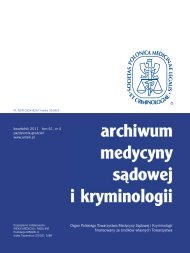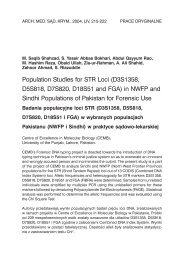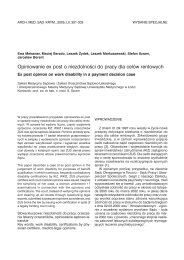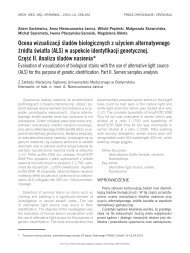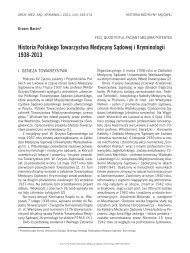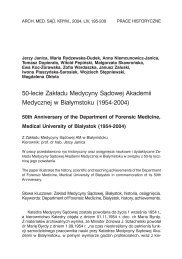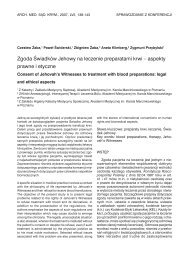PeÅny numer do pobrania (*.pdf) - Archiwum Medycyny SÄ dowej i ...
PeÅny numer do pobrania (*.pdf) - Archiwum Medycyny SÄ dowej i ...
PeÅny numer do pobrania (*.pdf) - Archiwum Medycyny SÄ dowej i ...
Create successful ePaper yourself
Turn your PDF publications into a flip-book with our unique Google optimized e-Paper software.
92 Łukasz Szleszkowski, Agata Thannhäuser, Jerzy Kawecki, Krzysztof Szwagrzyk, Barbara Świątek<br />
Nr 2<br />
entrance wounds situated within the posterior cranium<br />
and exit wounds or fractures corresponding<br />
to clear through exit bullet wounds located in the<br />
anterior part of the cranium.<br />
Type II – (6 cases, approximately 16%): with<br />
entrance wounds situated in the anterior part of the<br />
cranium and exit wounds or fractures corresponding<br />
to clear through exit bullet wounds located in<br />
the posterior cranium.<br />
Type III – (4 cases, approximately 10%): multiple<br />
gunshot injuries, a combination of type I and II.<br />
Type IV – (2 cases, approximately 5%): with entrance<br />
and exit wounds situated in the lateral cranial<br />
surfaces.<br />
Type V – (6 cases, approximately 16%) (including<br />
four cases with entrance and exit wounds situated<br />
i.a. in the posterior cranium): e.g. multiple<br />
gunshots to the head with various gunshot trajectories.<br />
An attempt at reconstructing the method of executing<br />
the death penalty ”by shooting”<br />
Capital punishment by shooting was executed<br />
in the described cases by firing a gunshot (gunshots)<br />
to the head. In none of the analyzed cases<br />
did the authors find any isolated gunshot injuries<br />
situated in the trunk or in regions other than the<br />
head. In seven cases, in addition to gunshot injuries<br />
to the head, concomitant injuries of other body<br />
areas (the neck, upper and lower extremities) were<br />
noted. In the vast majority of cases (28 – what accounts<br />
for 74%), gunshots were fired to the head<br />
from the back, hitting the occipital, cervico-occipital<br />
or posterior parietal region and pre<strong>do</strong>minantly<br />
causing extensive gunshot injuries of the head, at<br />
times with cervical spine damage. Gunshot injuries<br />
of the occipital region most commonly represented<br />
an isolated gunshot or several gunshots to this region<br />
or alternately were a part of a multiple gunshot<br />
to the head with gunshot trajectories extending<br />
in various directions. The above results allow for<br />
formulating a thesis that a gunshot fired to the back<br />
of the head was the most common method of execution<br />
”by shooting” employed in the Wrocław<br />
prison in the analyzed period. Only some gunshots<br />
were fired to the facial area of the head from the<br />
front or from the lateral part of the head. Based on<br />
inspection of cranial bones only (with no soft tissues<br />
present), one cannot formulate firm conclusions<br />
as to the distance from which gunshots were<br />
fired. Nevertheless, the character of cranial gunshot<br />
injuries, and especially very extensive comminuted<br />
fractures with skull fragmentation and extensive exit<br />
injuries allow for concluding that the gunshots were<br />
fired from a close distance, most likely from an immediate<br />
close distance, or were contact shots. In<br />
such a situation, the pre<strong>do</strong>minating finding is explosive<br />
fractures of the cranial bones due to a sudden<br />
increase of intracranial pressure [4]. The sizes<br />
of bullet wounds in cases when they may help in<br />
establishing bullet caliber are within a range of 0.7-<br />
0.9 cm, mostly ranging 0.75-0.8 cm, what may<br />
correspond e.g. to 7.62 or similar ammo. It is not<br />
possible to unambiguously determine the position<br />
of the individual being shot at with respect to the<br />
shooter, since in the majority of cases various spatial<br />
relations of the said persons were possible. Only<br />
in seven cases were the investigators able to hypothesize<br />
on the probable position of the shootee<br />
with respect to the rifleman. Thus, multiple gunshot<br />
injuries to the head with trajectories of various<br />
courses indicate possible gunshot fired to the<br />
head with a changing position of the shooter with<br />
respect to the shootee. The most probable situation<br />
seems to involve the first gunshot (gunshots)<br />
having been fired e.g. to the occiput followed by<br />
the convict falling <strong>do</strong>wn, with a subsequent gunshot<br />
(gunshots) fired to another part of the head,<br />
e.g. when the prisoner was lying <strong>do</strong>wn. Such a<br />
character may be ascribed to the observed gunshots<br />
to the vertex. Such gunshots might have been<br />
fired either in the above described circumstances<br />
or for example with the prisoner kneeling or sitting<br />
with his head flexed forward towards the sternum,<br />
when the vertex was easily accessible to the<br />
shooter standing in front of the convict. Gunshot injuries<br />
presented as case 112 (described in the previous<br />
part of the report) might have also been<br />
inflicted from the same position, with the exception<br />
of the fact that these gunshots were fired from the<br />
back to the cervico-occipital region, easily accessible<br />
for a rifleman standing behind the convict. In<br />
three cases, gunshot injuries to the head were accompanied<br />
by mandibular fractures inflicted by<br />
blunt, blunt-edged tools. The underlying mechanism<br />
might have been active or passive, e.g. the<br />
convict fell forward following a gunshot to the head<br />
without cushioning his fall with upper limbs (as<br />
2012 © by Polskie Towarzystwo <strong>Medycyny</strong> Są<strong>do</strong>wej i Kryminologii, ISSN 0324-8267



